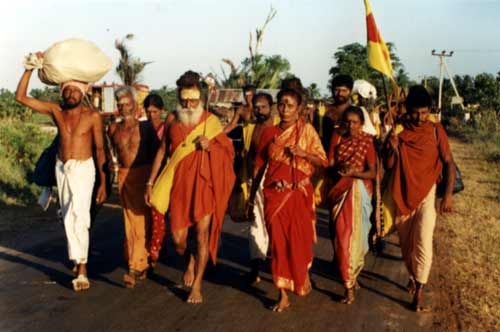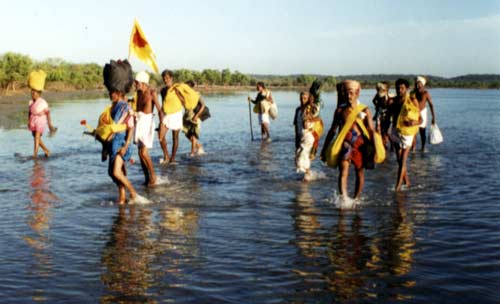
|
||||||||||||
|
| ||||||||||||
 The Long Road to Kataragama
(Colombo: The Sunday Observer) 24 May 1992Every year generally on the full moon day of Wesak or Poson, kapurālas (shaman-priests) at Kataragama perform the kap hitawīma or 'vow-fixing' ceremony of planting tree saplings in public view within the Kataragama god's modest Temple. The act is understood as a solemn pledge to undertake the elaborate fortnight-long Esala Festival in celebration of the god's colorful career, commencing 45 days later with the kodi-yētram or flag-hoisting ceremony at the Kataragama Mosque and culminating with the mystery-shrouded diya kapīma or water-cutting ceremony a fortnight later on the morning after the full moon. Also on the same day according to tradition, seasoned devotees who have assembled at the shrine of goddess Kannaki (Sanskrit: Pattini) at Varrāpalai near Mullaittivu far to the North set out on the first leg of the traditional 45-day Pāda Yātrā or foot pilgrimage to Kataragama in time for the flag-hoisting. Many of these pilgrims also renew old vows or make new ones to the Kataragama god. Hence, vows bind together the deity, devotees and rājakāriya ritual participants. A subtle, far-flung choreography of widely-separated events spans the length of the island in a dramatic ritual performance that annually recreates the entire mythic story of Kataragama. One of Lanka's most colourfully mysterious living traditions, the annual Kataragama Pāda Yātrā still serves unfathomed functions within Lankan society. Now even modern researchers are beginning to ask the same age-old question: Does the living spirit or god of Kataragama really exist in truth? The Kataragama Pāda Yātrā tradition may provide answers to this and other questions. If modern researchers could avail themselves of the same unseen living Presence as did the great jñānis (sages) and siddhas Authentic foot pilgrimage or pāda yātrā is a far cry from modern political protest marches. Unencumbered by political agendas or media teams, the traditional pilgrims instead prefer to entrust all arrangements to the sweet, if unpredictable, mercy of their irrascibly playful patron god. And despite the hardships they endure, few ever complain to the mischievious Skanda Kumāra except as ninda stuti or playful teasing. Winding down the island's east coast from one sacred site to another, the foot pilgrims bear up under scorching sun, rain, hunger and thirst, not to mention occasional encounters with wild animals, disease and even walking through military operations. To this day, to die en route is reckoned to be the ultimate distinction and a surefire sign of the Lord's disguised grace. Indeed, British colonial-era government agents used to complain of the tendency for Kataragama pilgrims to expire at or en route to the annual festival and played this as an argument to mandate 'tickets' issued to a tiny national quota of legal pilgrims to Kataragama in the late 19th century. The topsy-turvy logic of Kataragama and its traditions, some say, stems from its other-wordly perspective, through which the dvandvas or pairs of opposites are seen to be exchanging roles endlessly in perpetual play. As in Buddhist logic, opposites like waking and dreaming, wisdom and foolishness arise interdependently and have no absolute self-identity of their own. Kataragama's own traditions of secrecy, silence and 'the wisdom of the foolish' are still very much alive and well to this day, despite the vocal opinions of casual uninitiated observers. Attired as āntis or mendicant-beggars, the pilgrims walk, eat and worship together in small bands called kūttams. At night pilgrims camp much as gypsies do or, for that matter, much as tradition says the Kataragama god walked and camped from each of these sacred settings to another. Many still perform pindapāda - style door-to-door ritual begging for paddy or coins, not for mere sake of sustenance but knowlingly in order to bring blessings to the donor families. Every year small bands of god Kataragama's foot pilgrims pay their humble respects at major and minor shrines of various religions extending the length of the island. Among them are sites rich in sacred lore and legend such as Trincomalee's Koneswaram temple and the time--honoured shrines to Skanda-Murugan at Verugal, Siddhāndi (i.e. place of the siddha-āndi), Dandāmalai, Mantūr, Tirukkōvil and Okanda in Yala sanctuary, all of which are associated with the war god's colorful career in Lanka. Indeed, the Kataragama Pāda Yātrā is nothing less than a walking meditation or walking celebration of Lanka's sacred geographical and religious heritage from from one end of the island to the other. In order to protect and preserve Kataragama's endangered traditions such as the Pāda Yātrā, the Kataragama Devotees Trust was established in 1988. The strictly non-political character of the Pāda Yātrā and of the Trust has earned for them the respect and recognition of Sri Lankans of all communities. Since the initiation of the Kataragama Research Publications Project in 1989, substantial efforts have been made to document, analyse and present such living traditions as the Kataragama Pāda Yātrā, with foreigners also joining as participant-observers. Indeed, Sri Lanka may some day lead the world in exploring and promoting the novel concept of identifying and protecting the world's great sacred centres for the sake of countless generations yet to come. Patrick Harrigan, M.A. (U-Michigan, 1984) has been acting editor of the Kataragama Research and Publications Project since 1989 and webmaster of www.Kataragama.org since 1997. The 2002 Kataragama Pada Yatra was his sixteenth walk since 1972.
|

